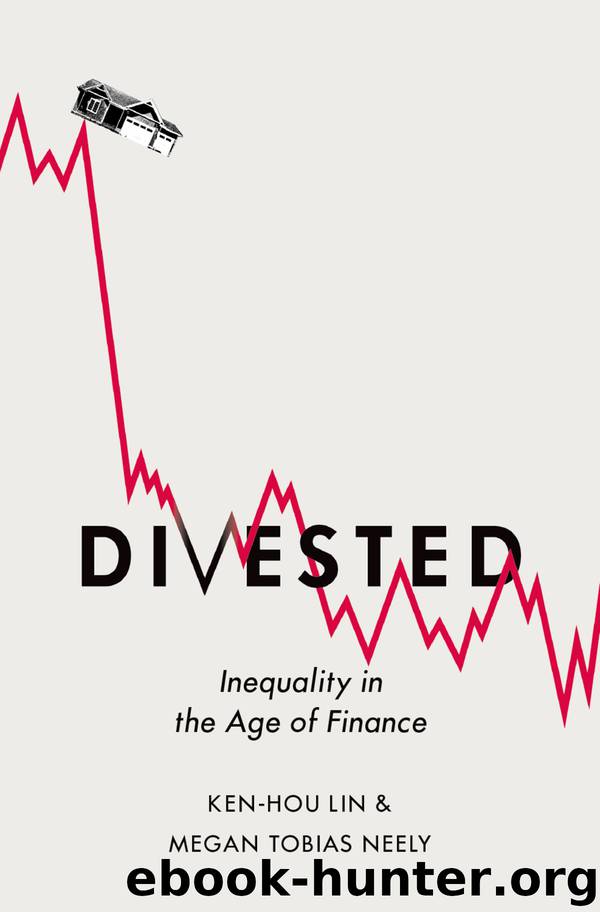Divested by Ken-Hou Lin

Author:Ken-Hou Lin
Language: eng
Format: epub
Publisher: Oxford University Press
Published: 2019-12-11T16:00:00+00:00
Expansion of Household Credit after World War II
A popular myth holds that the “Greatest Generation,” those who fought in World War II and returned home to create a baby boom, earned its way through hard work and thrift. Less is known about how consumer credit played a critical role in promoting widespread prosperity after the war. As soldiers returned and embarked on family life in the suburbs, access to low-interest credit for home purchase or entrepreneurship stimulated the postwar economy. Manufacturers, too, provided attractive payment plans to stimulate demand for their products. After two decades of turmoil, consumer credit seemed again a catalyst for rapid economic growth and an equalizer for standards of living.
Organized labor, like the reformers of the earlier era, supported credit expansion because it provided a much-needed safety net for the working class. Political economist Gunnar Trumbull (2014: 13) recounts, “Credit seemed to create a virtuous cycle, with new credit purchases driving scale in manufacturing, the resulting productivity increases enabling increases in wages.” Credit was applauded for allowing the middle and working classes to improve their quality of life.
The introduction of consumer credit cards also contributed to the debt of American households. Western Union introduced the first charge card in 1914, followed by hotel chains, department stores, and oil companies in the 1920s. Multiple-purpose cards, like the ones we know today, did not enter the mainstream until after World War II. The Diners Club card, introduced in 1950, led the trend by extending credit to restaurant-goers. The card charged a 7 percent interest rate and an annual fee but was extremely popular among affluent households who frequented high-end restaurants. In one year, it attracted 20,000 new members. Other lenders quickly started similar services, such as National Credit Card Inc., which provided a card targeted to traveling businessmen. American Express joined the credit business in 1958, sending 8 million potential customers application forms for credit cards modeled after the Diners Club. The number of banks offering credit cards grew from 27 in 1958 to 1,500 in 1967, servicing an estimated 11–13 million active accounts.
Despite taking on significantly more debt than their parents had, most American families were able to pay back their debts and build savings, owing to rapid wage growth and employment security grounded in the New Deal legislation. Every year after World War II, household borrowing grew, and so did repayment. Rates of outstanding debts remained constant over time. This ready access to credit provided the semblance of equality at least among working- and middle-class suburban households (the wealthy did not need to borrow for consumption, and the poor were still excluded from the credit market). Although half of clerical and factory workers lived in the suburbs—consistent with overall trends during the era—they were 1.5 times more likely to be in debt than their neighbors who worked as managers and professionals (Cherlin 2014). To some extent, these trends fulfilled the goals of progressive advocates for personal lending: debt helped to level inequality in consumption among households
Download
This site does not store any files on its server. We only index and link to content provided by other sites. Please contact the content providers to delete copyright contents if any and email us, we'll remove relevant links or contents immediately.
The Secret History by Donna Tartt(18843)
The Social Justice Warrior Handbook by Lisa De Pasquale(12141)
Thirteen Reasons Why by Jay Asher(8792)
This Is How You Lose Her by Junot Diaz(6792)
Weapons of Math Destruction by Cathy O'Neil(6142)
Zero to One by Peter Thiel(5685)
Beartown by Fredrik Backman(5594)
The Myth of the Strong Leader by Archie Brown(5424)
The Fire Next Time by James Baldwin(5248)
How Democracies Die by Steven Levitsky & Daniel Ziblatt(5127)
Promise Me, Dad by Joe Biden(5087)
Stone's Rules by Roger Stone(5026)
A Higher Loyalty: Truth, Lies, and Leadership by James Comey(4842)
100 Deadly Skills by Clint Emerson(4840)
Rise and Kill First by Ronen Bergman(4701)
Secrecy World by Jake Bernstein(4643)
The David Icke Guide to the Global Conspiracy (and how to end it) by David Icke(4624)
The Farm by Tom Rob Smith(4434)
The Doomsday Machine by Daniel Ellsberg(4415)
